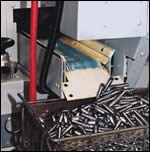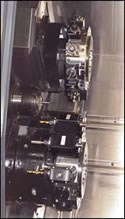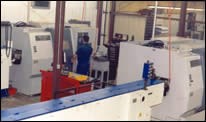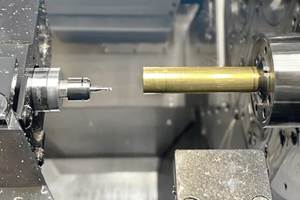Investing In New Business
When this South Carolina screw machine shop started losing jobs to China, it looked for ways to replace the lost business with more challenging jobs where labor costs are not the only consideration. The firm invested in a pair of turn-mill machines that run 24/7, producing parts complete in one setup. The new machining capability has attracted new business that more than compensates for that which was lost.
Share


Hwacheon Machinery America, Inc.
Featured Content
View More
Takumi USA
Featured Content
View More



.png;maxWidth=45)
DMG MORI - Cincinnati
Featured Content
View More

Autodesk, Inc.
Featured Content
View MoreSome shops that lose work to China and other low-wage countries react by freezing spending, laying off employees, going to shorter hours and, in general, doing what they can to hang on until business conditions improve. Other shops react by taking steps to replace the lost business with new business that is less vulnerable to cheaper labor rates. Sometimes those steps lead to substantial investments in newer, more productive equipment—a scary path in what are uncertain times for metalworking firms. However, the new equipment and the increased capabilities that it provides may be just the key to generating new and more profitable business.
Take, for example, Hogge Precision (Hartsville, South Carolina). Danny Hogge started the shop with two Brown & Sharpe single-spindle screw machines and a New Britain multi-spindle in 1989. He added more single- and multi-spindle screw machines as the business grew. The shop bought its first CNC lathe in 1992, and in time it expanded the CNC department with another CNC lathe and two vertical machining centers.
In the late 1990s, the shop began losing work as customers started purchasing screw machine parts, particularly brass parts, from China. Mr. Hogge’s son, Danny Hogge Jr., who is the operations manager for the family–owned business, estimates that the shop lost about $250,000 per year during a 4-year period because of work that went overseas. The amount of more traditional screw machine work going overseas continues to rise, which is causing many U.S. shops to scramble for ways to replace lost sales, he notes.
To offset its lost business, Hogge Precision began focusing on more difficult parts. In particular, it began looking at screw machine parts that required machining on both ends. The shop was able to do most of the machining of such parts on its multi-spindle screw machines—and in very competitive cycle times. However, the multi-spindle parts usually required one or more secondary operations.
Handling of the parts through the various operations not only increased the total cycle times for the parts, but it also increased production costs considerably. “Workers had to handle the parts as they came off the multi-spindles, put them into tote pans, carry them to the washing machine, carry them to the first secondary machining operation, machine them, take them back to washing, wash them…the man-hours required to process the parts through the entire operation made them too costly,” Mr. Hogge Jr. explains. “Also, processing of the parts through the various operations created the opportunity for mistakes at each step. We needed a process capable of completely machining the parts in a single setup to avoid the time and expense involved in performing secondary work on multi-spindle screw machine parts.”
New Machines
The shop took the problem to J&H Machine Tools (Charlotte, North Carolina), the area distributor for Mori Seiki U.S.A., Inc. (Irving, Texas). After reviewing Hogge Precision’s production requirements, J&H recommended the Mori Seiki ZT1500Y turning center, a CNC turn/mill machine with two spindles and two turrets capable of producing parts complete in one setup. The machine was capable of producing sophisticated turned parts with milled and drilled features in very competitive cycle times. The shop purchased two machines and contracted with J&H to turnkey their installation in a 12,000-square-foot plant addition built primarily for the purpose.
The ZT1500Y is configured with one 12-tool turret positioned above and behind the main spindle and a second 12-tool turret positioned below and in front. The turrets move in X and Z axes to serve both the main spindle and an identical subspindle located in line with and directly opposite the main spindle. The upper turret also has Y-axis movement (perpendicular to both the tool and workpiece axes) which permits off-center milling, drilling and tapping operations.
The two turrets accommodate up to 17 rotating tools (the rest are turning tools), providing all of the hole-making capability needed to completely machine sophisticated, hole-intensive, turned parts in one setup. Machining of the back end of the part in the subspindle occurs simultaneously with machining of the front end of the (next) part in the main spindle, reducing part cycle times. Machining operations can be divided between the turrets/spindles (where possible) to further reduce cycle times.
Hogge Precision’s main reason for buying the machines was to enable the shop to machine sophisticated turned parts complete in one setup with the lowest possible labor costs. The machines are capable of running around the clock 7 days per week, with long periods of unattended operation. To automate the loading of barstock in the machines, each machine is served by a 12-foot bar feed from Iemca Bar Feeders/GIULIANI. Each bar feed is equipped with a bundle loader capable of holding up to 5,000 pounds of barstock at a time.
“We were pleased enough with the performance of our existing Mori Seiki CNC lathes and vertical machining centers, so we had no problem with J&H Machine Tool’s recommendation of the Mori Seiki turning centers,” Mr. Hogge recalls. “However, we were less sure about the need for the bar feeds, so J&H took us to another of its customers using bar feeds with bundle loaders. One look was enough to convince us that we needed them.
Automated Bar Loading
“A bar feed equipped with a bundle loader costs more than a magazine-style bar feed, but it’s well worth the extra expense because there is less material handling by the operators,” he continues. “The name of the game is to reduce labor costs wherever possible to remain competitive. With the magazine bar feed, an operator must handle each bar individually and load in on a rack. If you’re running 2-inch-diameter steel bar, that’s a pretty heavy chunk of metal, and you need two people for the loading. With the bundle loader, however, you only need one person to load an entire bundle using an overhead crane.
“We have one job where we load 2,000 pounds of bar into the bundle loader, and the machine runs for a week or more without stopping,” Mr. Hogge explains. “For that same job, if we chose to, we could load 4,000 pounds of bar into the machine—the maximum load for the overhead crane—and run without stopping for 2 to 3 weeks.”
Automated Parts Unloading
Unloading of machined parts to a parts basket is similarly automated. The turning center’s integral, traveling parts catcher comes forward to the machining area, grips the machined part, returns to the rear of the machine and drops the part onto a short conveyor that delivers it to a basket. It takes 2 to 8 hours to fill the basket, depending on the size of the part. When a basket is full, it is moved by overhead crane to one of two part-washing tanks. There is no handling of individual parts by the operators. From the wash tanks, the baskets go onto rollers, beneath which are drain pans that catch wash water draining from the just-washed parts. The parts continue to the scales, where they are weighed and packed into boxes. They are then ready for shipment to the customer.
Optional features were selected to support the machines’ ability to run unattended for long periods. For example, a tool life management program keeps track of tool life for specific operations. Once a job has been run and it has been established that a tool can be used to machine, say, 800 parts before wear becomes unacceptable, a backup tool can be installed in the turret and the machine can be programmed to switch to that tool at 800 pieces. This eliminates the need to stop the machine for a tool change.
As is the case with most new machine tool acquisitions, Hogge Precision bought the two turning centers to produce a specific family of parts. And as is the case with many new machine tool acquisitions, the shop lost the job for which the equipment was purchased. Before that happened, however, the shop discovered that the machines could do a lot more than just the job for which they were purchased. “We discovered they could do everything,” Mr. Hogge stresses. “We started quoting jobs based on running them on the ZTs, and our prices were so competitive that we started getting new customers.”
One new customer is a large agricultural equipment manufacturer that had been machining pin-type parts in-house in two or three operations with a total cycle time of 4 to 5 minutes. Hogge Precision is able to completely machine the parts on the ZT in a cycle time of just under 2 minutes.
Mostly New Jobs
The shop intended to get the word out about its new machining capability, but that turned out not to be necessary. “As soon as the machines were up and running, people started knocking on our doors asking us to make parts for them,” Mr. Hogge says. He notes that 80 percent of the jobs running on the turning centers are jobs acquired since the shop obtained the new machines. The remaining 20 percent are challenging repeat jobs transferred from the shop’s single- and multi-spindle screw machines.
Jobs that run on the turning centers are typically low-volume, short-leadtime, high-precision parts. “We’re looking for the more challenging jobs that, for whatever reason, cannot go to China,” Mr. Hogge stresses. “We don’t expect to be able to hold on to jobs involving parts made of brass with tolerances of plus or minus five thousandths. They’re gone.”
24/7
Labor costs to operate the turning centers are minimal, primarily because of the long periods that the machines run unattended. Hogge Precision operates an 8-hour first shift and a 10-hour second shift. The shop shuts down at 2 a.m. and starts up at 7 a.m. During each of the shifts, one operator monitors both turning centers, loading bundles of 12-foot-long bars into the bundle loader and replacing full baskets of machined parts with empty baskets as required using an overhead crane. During the 5-hour period when no employees are present, the turning centers operate in an unattended mode.
The turning centers work around the clock on the weekends, providing a combined 60 hours or so of unattended operation. A setup person comes in every 12 hours to make any needed tool or program changes, check the operation of the machines, check coolant and oil levels and, in general, make sure everything is OK.
One More Tool
By investing in the turning centers, Hogge Precision added an important new tool to its toolbox. But it didn’t throw away any of its existing tools in the process. Management believes that the more tools it has to solve its customers’ problems, the better its competitive position will be. Mr. Hogge cites as an example a firm that relocated a manufacturing plant to the Carolinas. The plant needed a shop that could not only produce screw machine parts but could also machine castings. Because Hogge Precision was the only shop in the area able to satisfy both of the manufacturer’s requirements, it was awarded the business.
Similarly, the shop recently bid for a job against several area shops. The competitors bid on the basis of doing the job on CNC lathes with cycle times of about 60 seconds. Hogge Precision bid on the basis of doing the job on its multi-spindle screw machines—with a cycle time of 10 seconds—and got the job.
“We still think of ourselves as a screw machine shop,” Mr. Hogge insists. “However, where not too long ago our CNC machines complemented our screw machines, today it’s just the opposite. Our recent purchase of the turning centers simply acknowledges the fact that as more and more high-volume, relatively simple screw machine work goes overseas, we need to concentrate on more sophisticated parts that cannot be made overseas on multi-spindle screw machines manned by operators making pennies an hour. We’re improving our ability to produce parts in smaller lot sizes more efficiently and to produce them in much shorter time frames and at more competitive unit costs.”
Is Hogge Precision planning to add a third or fourth turning center in the near future? “I’d have a building full of them if I could afford it,” Mr. Hogge admits. “Screw machines are an important part of our company’s production and will continue to be for the foreseeable future. Manufacturing firms are always going to need parts that simply involve feed, form and cutoff, and you can’t beat a screw machine for that.
“That said, however, we’ve thought about the fact that our turning centers are capable of producing just about any two-ended part we’ve ever made, and that if we had a few more turning centers, we could probably make about 85 percent of our parts on them profitably,” he adds. “It’s an intriguing prospect.”
Hogge Precision’s investment in new equipment appears to be paying off. “Since 2000, sales had been relatively flat,” Mr. Hogge explains. “However, fiscal 2003 was our best year since 1998, which was a good year, and 2004 looks to be about the same. We had to lay off six employees because of the last wave of job losses to China, but we’ve called some of them back as business has improved—and it’s new business that is going to stay. It’s not going to go away.”
Branching Out
By the time you read this, Hogge Precision will have added still another new CNC machine. Interestingly, the new machine is a horizontal machining center—also a Mori Seiki machine purchased from J&H Machine Tool—which is a little surprising, given the shop’s strong turned parts orientation.
“Actually, we offer our customers a broad range of machining capabilities, such as thread rolling, centerless grinding, gundrilling and crush grinding, so it’s not that unusual for us to be purchasing something other than a turning machine,” Mr. Hogge explains. “We’ll be using the new machining center to machine large castings. It’s something new for us, but we’re branching out. There isn’t as much of the traditional screw machine work that once comprised the bulk of our production, so we’re finding other things to do.”
Related Content
3 Tips to Accelerate Production on Swiss Lathes with Micro Tools
Low RPM lathes can cause tool breakage and prevent you from achieving proper SFM, but live tooling can provide an economical solution for these problems that can accelerate production.
Read MoreOkuma Demonstrates Different Perspectives on Automation
Several machine tools featured at Okuma’s 2023 Technology Showcase included different forms automation, from robots to gantry loaders to pallet changers.
Read MoreCNC Machine Shop Honored for Automation, Machine Monitoring
From cobots to machine monitoring, this Top Shop honoree shows that machining technology is about more than the machine tool.
Read MoreDN Solutions Launches New Series of Turning Machines
The Puma DNT Series is equipped with a powerful spindle, a redesigned turret body and live tool drive that provide precise machining and productivity.
Read MoreRead Next
5 Rules of Thumb for Buying CNC Machine Tools
Use these tips to carefully plan your machine tool purchases and to avoid regretting your decision later.
Read MoreRegistration Now Open for the Precision Machining Technology Show (PMTS) 2025
The precision machining industry’s premier event returns to Cleveland, OH, April 1-3.
Read MoreBuilding Out a Foundation for Student Machinists
Autodesk and Haas have teamed up to produce an introductory course for students that covers the basics of CAD, CAM and CNC while providing them with a portfolio part.
Read More















































